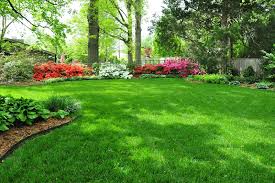
7 Best ways to maintain your lawn this spring
Since herbicides have come off the market in in several places, many people puzzle over the right strategy to keep their lawns healthy. Fear not! All the turf management tools you need follow below. Proper lawn care techniques, done at the right time, can make your lawn greener than it's ever been!
If your schedule gets in the way, consider either one-time services or a seasonal program from a professional landscape company.
Step 1:Aerating and Thatch Control
- Aerate in the spring and fall before top dressing or fertilizing.
- Aerators can be rented or lawn care companies can provide the service.
- Alleviates compacted soil and allows water to penetrate deeper, producing deeper roots.
- Creates space in soil for penetration of air, water and nutrients.
- Physically breaks up thatch.
- A healthy lawn has 1 cm (1/2 inch) of thatch - more than 2.5 cm is too much.
- Unhealthy amounts of thatch prevent water and nutrients from reaching roots.
- Thatch can harbour insects and diseases.
- Use a de-thatching machine or hire a lawn care company.
Step 2 : Improving Soil Quality
- Grass grows best in a moist, fertile soil that is not waterlogged.
- Sandy soil and heavy clay both need humus to improve the texture.
- A deep dense root system is most important to support top growth in grass.
- A minimum of 4 in. (10 cm) of soil is needed.
- More soil = deeper roots.
- Soil samples can be sent for analysis. The results will include levels of phosphorus, potassium, pH and lime.
- pH levels are the measurement of acid and alkaline level. The optimum level is between 6.0 and 7.0.
- Top dress lawn with good quality top soil (1/4 to 1/2 inch), consisting of loam, peat moss and compost, to improve soil conditions.
- Can be combined with overseeding.
- Top-dressing and overseeding are ideal opportunities to introduce drought-resistant grass mixes.
- Best time is early fall, but can be done in spring if there is winter damage.
- Red fescue tolerates shade and drought conditions, requires low-fertility, rows well in the sun, has very fine leaves and spreads by runners.
- Perennial rye grass is drought tolerant, prefers full sun, but tolerates shade.
- Many perennial rye grasses contain levels of endophytic fungus, which help the roots take up water and nutrients. Hairy chinch bugs, bluegrass billbugs and sod webworms don't like the taste.
- Perennial rye grass retains its green colour very well during mid-summer heat stress.
- Mow high: 6 to 8 cm (approx 3 in.).
- Keep mower blades sharp.
- Mow frequently - cut no more than 1/3 of shoot length.
- Leave clippings on the lawn to provide a natural source of nitrogen.
- Very important to grass health.
- Provides nutrients to out grow weeds.
- Use a slow release type of fertilizer, and follow instructions.
- Use a spreader for even application.
- Consider using organic fertilizers.
- Apply a fertilizer specifically formulated for turfgrass. An established lawn with a good root system can seek out phosphorous already in the soil. The Lawn Care Sector Group of Landscape Ontario recommends using a phosphorus-free fertilizer on established turf.
- Nitrogen needs to be applied each year.
- Phosphorus and potassium are stable in soil.
- Late fall fertilization is best to increase fall and spring root growth and also results in an early spring green up.
- Promotes a thicker lawn.
- Timing is critical - in the fall, the turf has stopped growing above the soil, but the roots are still active.
- Follow-up with late May, early June fertilization (consider corn gluten meal and deal with crabgrass at the same time).
Step 6: Spot check for weeds and insects
- Integrated Pest Management is as good as conventional pest management.
- Pull any broadleaf weeds by hand.
- Annual weeds: prevent flowering by mowing and/or hand pulling.
- Grass weeds: apply a pre-emergent (prevents germination) treatment. Try corn gluten meal Turf Maize.
- Perennial rye grass mix will minimize chinch bugs, bluegrass billbugs and sod webworms.
- Apply nematode spray for grubs.
- Let a healthy lawn go dormant during extended dry periods. It can survive four to six weeks without adequate water.
- Water only during an extreme drought or if lawn is under stress or renovation to begin with. If your lawn is dormant:
- Check regularly for insect pests
- Keep traffic off
- Stop mowing
- Do not fertilize
If you do water:
- Water deeply: 2.5 cm (one inch).
- Water infrequently: Less than once a week.
- Water before 10:00 a.m. to avoid evaporation and for best health.
- Follow any regional watering restrictions.